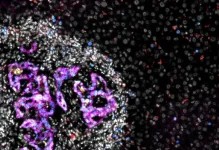(Press-News.org) ITHACA, N.Y. – A new Cornell University study provides evidence that a spillover of avian influenza from birds to dairy cattle across several U.S. states has now led to mammal-to-mammal transmission – between cows and from cows to cats and a raccoon.
“This is one of the first times that we are seeing evidence of efficient and sustained mammalian-to-mammalian transmission of highly pathogenic avian influenza H5N1,” said Diego Diel, associate professor of virology and director of the Virology Laboratory at the Animal Health Diagnostic Center in the College of Veterinary Medicine.
Diel is co-corresponding author of the study, “Spillover of Highly Pathogenic Avian Influenza H5N1 Virus to Dairy Cattle” which is under embargo until 11am ET on July 25 in Nature.
Whole genome sequencing of the virus did not reveal any mutations in the virus that would lead to enhanced transmissibility of H5N1 in humans, although the data clearly shows mammal-to-mammal transmission, which is concerning as the virus may adapt in mammals, Diel said.
So far, 11 human cases have been reported in the U.S., with the first dating back to April 2022, each with mild symptoms: four were linked to cattle farms and seven have been linked to poultry farms, including an outbreak of four cases reported in the last few weeks in Colorado. These recent patients fell ill with the same strain identified in the study as circulating in dairy cows, leading the researchers to suspect that the virus likely originated from dairy farms in the same county.
While the virus does have the ability to infect and replicate in people, the efficiency of those infections is low. “The concern is that potential mutations could arise that could lead adaptation to mammals, spillover into humans and potential efficient transmission in humans in the future,” Diel said.
It is therefore critical to continue to monitor the virus in affected animals and also in any potential infected humans, Diel said. The U.S. Department of Agriculture has funded programs for H5N1 testing, at no cost to producers. Early testing, enhanced biosecurity and quarantines in the event of positive results, would be necessary to contain any further spread of the virus, according to Diel.
Infections from H5N1 were first detected in January 2022, and have resulted in the deaths of more than 100 million domestic birds and thousands of wild birds in the U.S. The Cornell AHDC's and Texas A&M Veterinary Medical Diagnostic Laboratory scientists were among the first to report detection of the virus to dairy cattle herds. The cows were likely infected by wild birds, leading to symptoms of reduced appetite, changes in fecal matter consistency, respiratory distress and abnormal milk with pronounced decrease in milk production.
The study shows a high tropism of the virus (capability to infect particular cells) for the mammary gland and high infectious viral loads shed in milk from affected animals.
Using whole genome sequencing of characterized viral strains, modeling and epidemiological information, the researchers’ determined cases of cow to cow transmission when infected cows from Texas were moved to a farm with healthy cows in Ohio. Sequencing also showed that the virus was transmitted to cats, a raccoon and wild birds that were found dead on affected farms. The cats and raccoon most likely became ill from drinking raw milk from infected cows. Though it isn’t known how the wild birds became infected, the researchers suspect it may have resulted from environmental contamination or aerosols kicked up during milking or cleaning of the milking parlors.
Kiril Dimitrov, assistant agency director for microbiology and research and development at the Texas A&M Veterinary Medical Diagnostic Laboratory, is also a co-corresponding author.
Co-first authors include Leonardo Caserta, assistant research professor and interim associate director of the Virology Laboratory at AHDC, and Elisha Frye, DVM ‘10, assistant professor of practice, both in the Department of Population Medicine and Diagnostic Sciences; and Salman Butt, a postdoctoral researcher in Diel’s lab. Cornell co-authors include Melissa Laverack, Mohammed Nooruzzaman, Lina Covaleda, Brittany Cronk, Gavin Hitchener, John Beeby, Manigandan Lejeune and Francois Elvinger.
The study was funded by the AHDC, the Ohio Animal Disease and Diagnostic Laboratory, the Texas A&M Veterinary Medical Diagnostic Laboratory and the USDA.
-30-
END
New study confirms mammal-to-mammal avian flu spread
2024-07-24
ELSE PRESS RELEASES FROM THIS DATE:
MD Anderson Research Highlights for July 24, 2024
2024-07-24
HOUSTON ― The University of Texas MD Anderson Cancer Center’s Research Highlights showcases the latest breakthroughs in cancer care, research and prevention. These advances are made possible through seamless collaboration between MD Anderson’s world-leading clinicians and scientists, bringing discoveries from the lab to the clinic and back.
Recent developments at MD Anderson include low-dose radiation for B-cell lymphoma, a target for overcoming treatment resistance in pancreatic cancer, decreased public trust in U.S. health agencies providing cancer information, ...
Building a molecular brain map to understand Alzheimer’s disease
2024-07-24
Less than a decade ago, when Dr. Hansruedi Mathys launched an ambitious project to create an annotated library of all the gene readouts stored within 100 individual brain cells, the task felt daunting.
Now, with technological advances, Mathys successfully mapped out such ‘transcriptomes’ from not just 100, but from 1.3 million brain cortex cells from 48 individuals with and without Alzheimer’s disease.
Mathys, who pioneered single-cell transcriptomic analysis on post-mortem human brain tissue during his postdoctoral training and is now an assistant professor of neurobiology at the University of Pittsburgh School of Medicine, says that the resulting ...
Trees reveal climate surprise – bark removes methane from the atmosphere
2024-07-24
Tree bark surfaces play an important role in removing methane gas from the atmosphere, according to a study published today (24 July) in Nature.
While trees have long been known to benefit climate by removing carbon dioxide from the atmosphere, this new research reveals a surprising additional climate benefit. Microbes hidden within tree bark can absorb methane – a powerful greenhouse gas – from the atmosphere.
An international team of researchers led by the University of Birmingham has shown for ...
Webb images nearest super-Jupiter, opening a new window to exoplanet research
2024-07-24
“We were excited when we realised we had imaged this new planet”, said Elisabeth Matthews, a researcher at the Max Planck Institute for Astronomy in Heidelberg, Germany. She is the main author of the underlying research article published in the journal Nature. “To our surprise, the bright spot that appeared in our MIRI images did not match the position we were expecting for the planet”, Matthews points out. “Previous studies had correctly identified a planet in this system but underestimated this super-Jupiter gas giant’s ...
Social vulnerability linked with mental health and substance use disorders
2024-07-24
A new study published in JAMA Psychiatry uncovers significant associations between social vulnerability — a measurement that aggregates social determinants of health like socioeconomic status, housing type, education and insurance coverage — and the prevalence and treatment of mental health and substance use disorders in the United States. The results have the potential to reshape public health policies to better serve systemically disadvantaged populations.
Powerful analysis of meaningful data
“We're continually learning that so much of healthcare — both mental health and physical health — is impacted by the environment ...
Insurance type and withdrawal of life-sustaining therapy in critically injured trauma patients
2024-07-24
About The Study: In this cohort study of U.S. adult trauma patients who were critically injured, patients who were uninsured underwent earlier withdrawal of life-sustaining therapy compared with those with private or Medicaid insurance. Based on the findings of this study, a patient’s ability to pay was likely associated with a shift in decision-making for withdrawal of life-sustaining therapy, suggesting the influence of socioeconomics on patient outcomes.
Corresponding Author: To contact the corresponding author, Graeme Hoit, M.D., email graeme.hoit@mail.utoronto.ca.
To ...
Physician posttraumatic stress disorder during COVID-19
2024-07-24
About The Study: The findings of this study suggest that physicians were more likely to experience posttraumatic stress disorder (PTSD) during the COVID-19 pandemic. Targeted interventions to support physician well-being during traumatic events like pandemics are required.
Corresponding Author: To contact the corresponding author, Manish M. Sood, M.D., email Msood@toh.on.ca.
To access the embargoed study: Visit our For The Media website at this link https://media.jamanetwork.com/
(doi:10.1001/jamanetworkopen.2024.23316)
Editor’s ...
Social isolation changes and long-term outcomes among older adults
2024-07-24
About The Study: Increased isolation was associated with elevated risks of mortality, disability, and dementia, irrespective of baseline isolation status in this cohort study. These results underscore the importance of interventions targeting the prevention of increased isolation among older adults to mitigate its adverse effects on mortality, as well as physical and cognitive function decline.
Corresponding Author: To contact the corresponding author, Judy Zhong, Ph.D., email judy.zhong@nyumc.org.
To access the embargoed study: Visit our For The Media website at ...
Under pressure: how cells respond to physical stress
2024-07-24
Cell membranes play a crucial role in maintaining the integrity and functionality of cells. However, the mechanisms by which they perform these roles are not yet fully understood. Scientists from the University of Geneva (UNIGE), in collaboration with the Institut de biologie structurale de Grenoble (IBS) and the University of Fribourg (UNIFR), have used cryo-electron microscopy to observe how lipids and proteins at the plasma membrane interact and react to mechanical stress. This work shows that, depending on conditions, small membrane regions can stabilize ...
Preventing cancer cells from colonizing the liver
2024-07-24
In brief:
ETH Zurich researchers have discovered proteins on the surface of colorectal cancer cells and liver cells that bind together and that play a major role in the formation of new metastases.
The binding of the proteins triggers fundamental changes in colorectal cancer cells that allow them to take root in the liver.
These new findings will help to develop future treatments that may hinder the formation of often fatal metastases.
In cases where cancer is fatal, nine out of ten times the culprit is metastasis. This is when the primary tumour has sent out cells, like seeds, and invaded other organs of the body. While medicine has made great progress in treating primary tumours, ...


